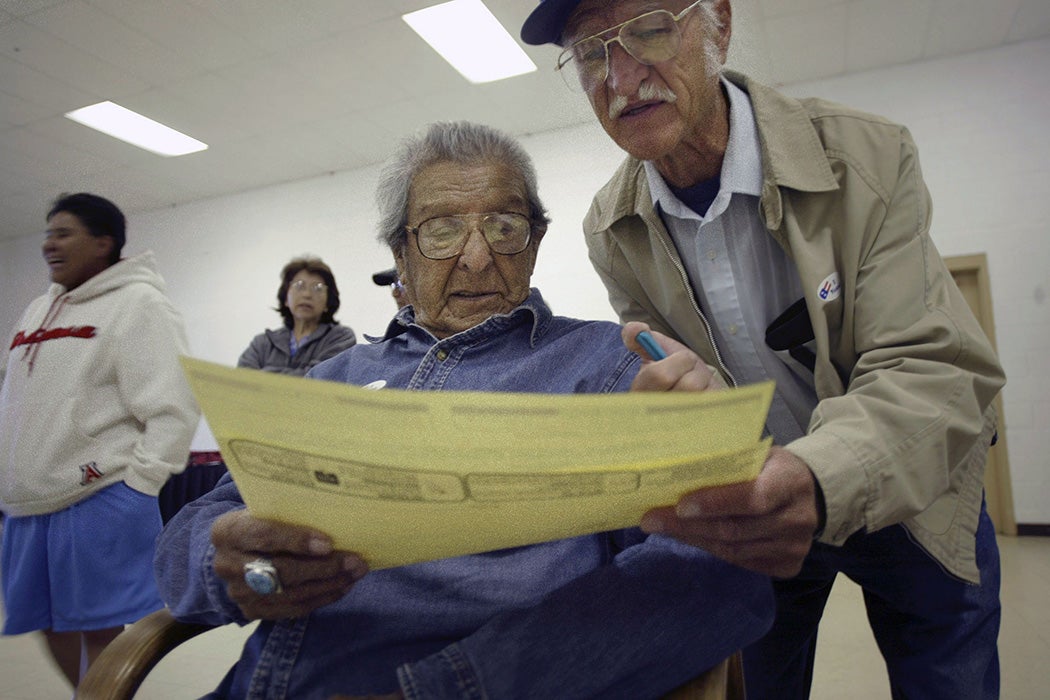In June 1986, Judge Edward Rafeedie handed down a ruling. Indigenous voting rights were being suppressed in Montana’s Big Horn County, where “official acts of discrimination…have interfered with the rights of Indian citizens…to register and vote.” This was a victory for voting equality, but it wasn’t met with open arms. County Commissioner Ed Miller, for example, was dismayed, citing a longing for the “good old days.”
“The Voting Rights Act is a bad thing,” Miller claimed, according to the San Francisco Examiner. “[T]hings were fine around here. Now they (Indians) want to vote. What next?”
Maybe most weren’t as vocal about their opposition to equal rights as Miller was, but the Native American franchise was a hard-fought battle. As historian Matthew G. McCoy writes, “Only through consistent activism and legal action did Native Americans succeed in breaking down these egregious barriers to voting.”
It shouldn’t have been as difficult for Native Americans to vote as it was. The Indian Citizenship Act of 1924, in theory, settled the question of whether Indigenous people were citizens. They were. And they were entitled to vote. However, as historian Orlan J. Svingen explains, this law didn’t prevent discrimination.
A government study in 1936, for example, found that seven states were actively preventing Native Americans from voting. Much like the laws that prevented Black Americans from voting, these states enacted laws specifically targeting Native American voters, including mandating that all voter registrars be taxpayers (many Native Americans were exempt from certain local taxes, and this law depressed voter registrations on reservations) and literacy tests as a requirement for voting. One Cherokee voter was told by a judge that despite his master’s degree from the University of North Carolina, “You couldn’t read or write to my satisfaction if you stayed here all day.”
Though there was anger and a number of court battles in earlier years, it may have been the start of World War II that acted as a catalyst for activism, McCoy notes. Though Native American soldiers were being sent overseas to fight for freedom, that same freedom eluded them at home. Navajo soldier Ralph Anderson sent a letter to tribal leaders in 1943 with this exact contradiction on his mind.
“We all know Congress granted the Indians citizenship in 1924,” he wrote, “but we still have no privileges to vote. We do not understand what kind of citizenship you would call that.”
Weekly Newsletter
In the following years, Native activists took their fight to Congress several times, meeting denials of their rights most times. But they were undeterred and began leading direct actions. In 1946, for example, Navajo citizens attempted to register to vote in Arizona and were denied, as were two people from the Yavapai tribe. The latter denial led to a court case, Harrison v. Laveen, that overturned a previous ruling that classified Native Americans living on reservations as being essentially wards of the state and ineligible for voting. A case in 1948 successfully took the fight to the federal government, arguing that the denial of voting rights was unconstitutional. And as Svingen writes, in the 1970s, “exemptions from certain taxes no longer limits [Native Americans’] right to vote, and election districts must be apportioned under the ‘one person one vote’ principle,” rules that officials in Big Horn County were simply ignoring.
There have been many subsequent fights for equality, and some experts argue that certain regulations, like voter ID, may still be playing a role in disenfranchising Native American voters. Legal scholar Sally Harrison writes that “one in five eligible Native American voters do not have a [government-issued] photo ID that meets the requirements for ID in strict-photo ID states [and] many states do not allow tribal photo IDs at the polls because a state or federal government did not issue them,” a contradiction that could lead to revisiting past injustices. As Harrison notes, “state and federal legislators should pay special attention to the Native American vote, making sure that it does not face the discrimination and exclusion it has in the past.”







